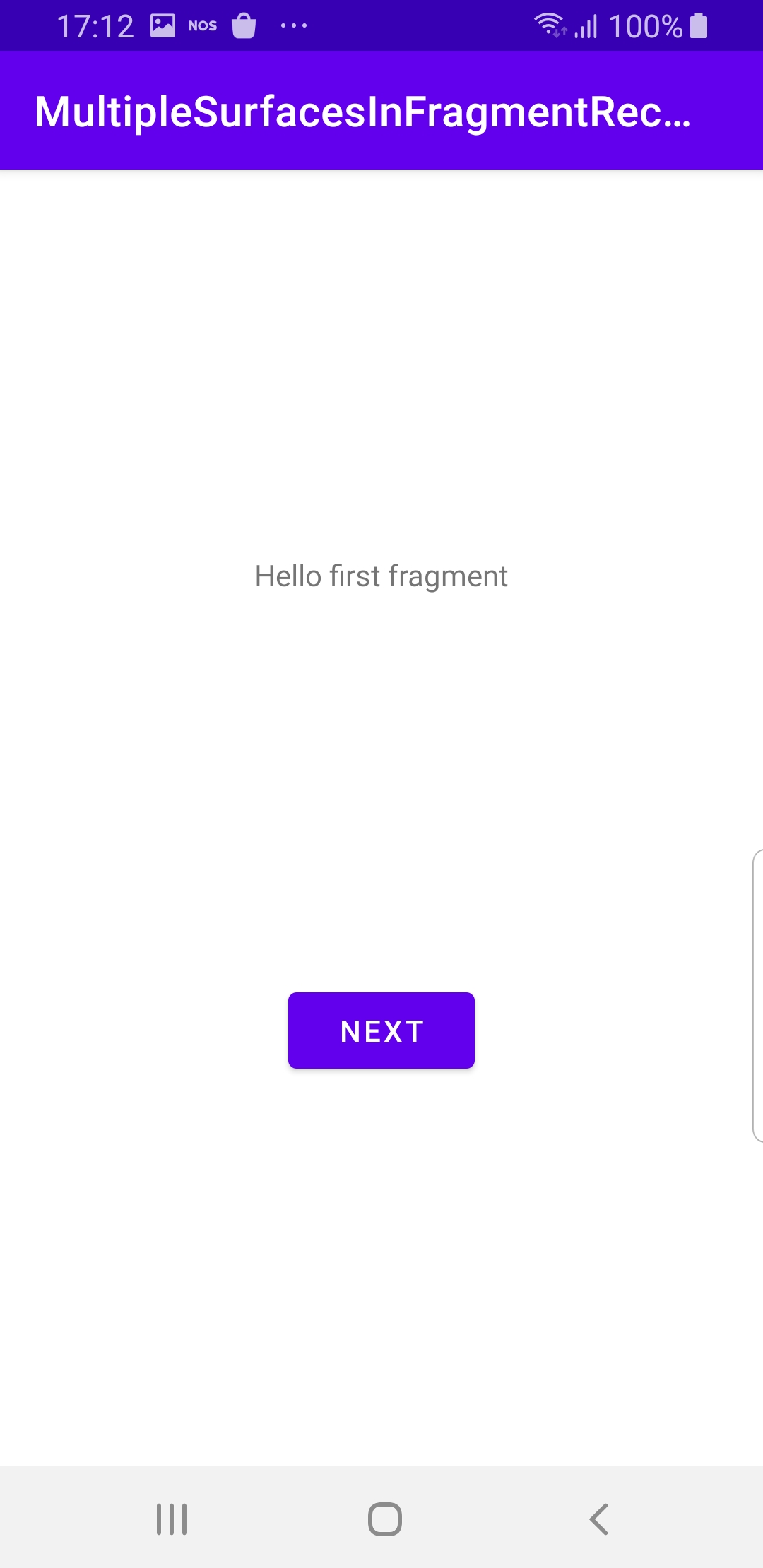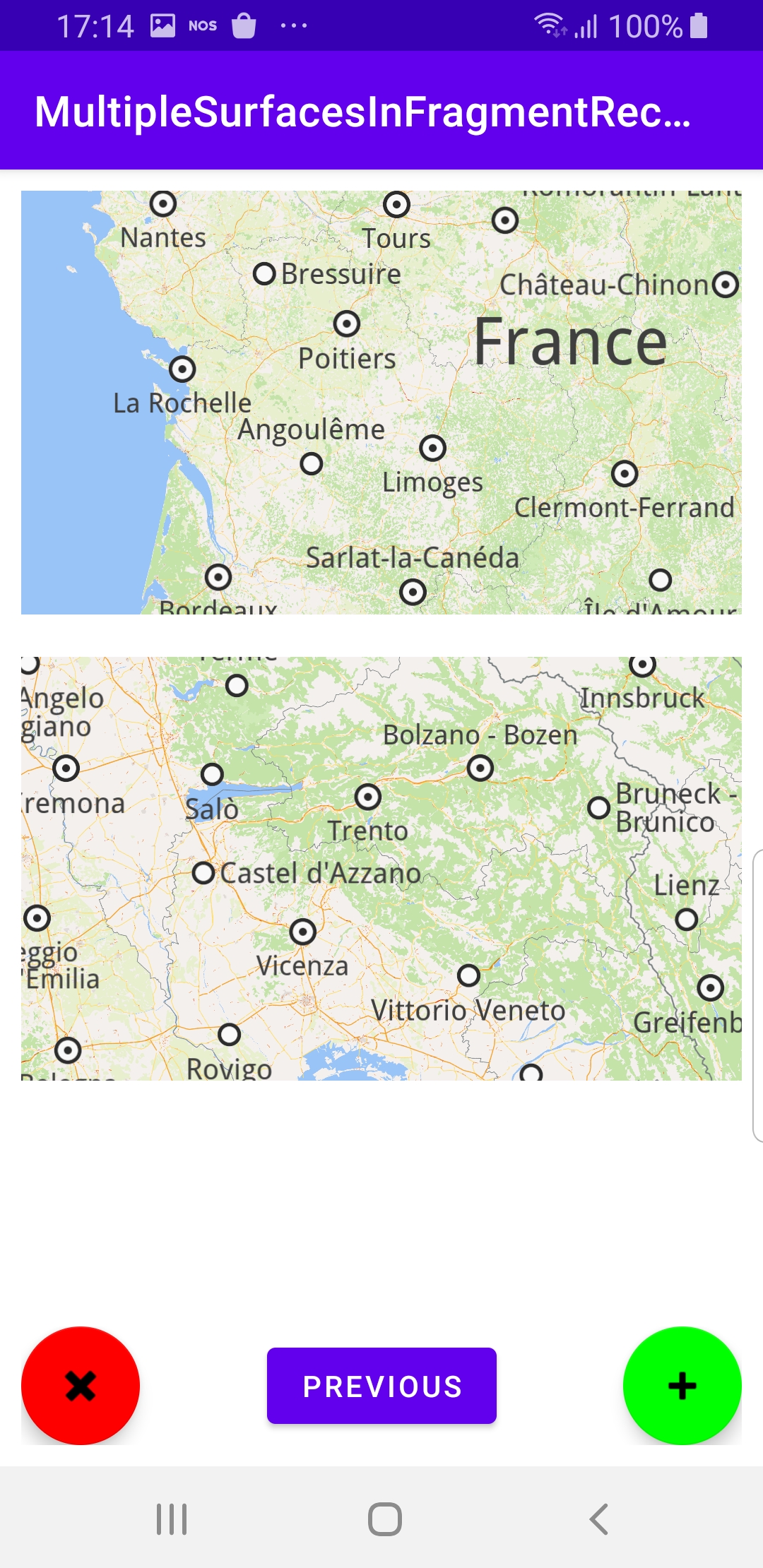Multiple Surfaces in Fragment Recycler ¶
Setup ¶
First, get an API key token, see the Getting Started guide.
Download the Maps & Navigation SDK for Android archive file
Download the
MultipleSurfacesInFragmentRecycler
project
archive file or clone the project with Git
See the Configure Android Example guide.
Run the example ¶
In Android Studio, from the
File
menu, select
Sync
Project
with
Gradle
Files
|
|
|
How it works ¶

You can open the MainActivity.kt file to see how to render multiple maps, and add or remove maps.
1class FirstFragment : Fragment()
2{
3 override fun onCreateView(
4 inflater: LayoutInflater, container: ViewGroup?,
5 savedInstanceState: Bundle?
6 ): View? {
7 return inflater.inflate(R.layout.fragment_first, container, false)
8 }
9 override fun onViewCreated(view: View, savedInstanceState: Bundle?)
10 {
11 super.onViewCreated(view, savedInstanceState)
12 view.findViewById<Button>(R.id.button_first).setOnClickListener
13 {
14 findNavController().navigate(R.id.action_FirstFragment_to_SecondFragment)
15 }
16 }
17}
The first fragment. When the first fragment instantiation is complete, a click listener is added to the button to go to the second fragment.
1override fun onCreateView(
2 inflater: LayoutInflater, container: ViewGroup?,
3 savedInstanceState: Bundle?
4 ): View? {
5 return inflater.inflate(R.layout.fragment_second, container, false)
6 }
7 override fun onViewCreated(view: View, savedInstanceState: Bundle?) {
8 super.onViewCreated(view, savedInstanceState)
9 view.findViewById<Button>(R.id.button_second).setOnClickListener {
10 findNavController().navigate(R.id.action_SecondFragment_to_FirstFragment)
11 }
12 recycler = view.findViewById<RecyclerView>(R.id.list).apply {
13 itemAnimator = null
14 layoutManager = LinearLayoutManager(requireContext())
15 adapter = CustomAdapter(list)
16 }
17 val leftBtn = view.findViewById<FloatingActionButton>(R.id.bottomLeftButton)
18 leftBtn.visibility = View.VISIBLE
19 buttonAsDelete(requireContext(), leftBtn) {
20 deleteLastSurface()
21 }
22 val rightBtn = view.findViewById<FloatingActionButton>(R.id.bottomRightButton)
23 rightBtn.visibility = View.VISIBLE
24 buttonAsAdd(requireContext(), rightBtn) {
25 addSurface()
26 }
27}
1private fun addSurface() {
2 if (list.size >= maxSurfacesCount) {
3 return
4 }
5 list.add(list.lastIndex + 1)
6 recycler.adapter?.notifyItemInserted(list.lastIndex)
7 }
8 private fun deleteLastSurface() {
9 if (list.size == 0) return
10 list.removeLast()
11 recycler.adapter?.notifyItemRemoved(list.lastIndex + 1)
12 }
13 private fun buttonAsAdd(context: Context, button: FloatingActionButton?, action: () -> Unit) {
14 button ?: return
15 val tag = "add"
16 val backgroundTintList =
17 AppCompatResources.getColorStateList(context, R.color.green)
18 val drawable = ContextCompat.getDrawable(context, android.R.drawable.ic_input_add)
19 button.tag = tag
20 button.setOnClickListener { action() }
21 button.setImageDrawable(drawable)
22 button.backgroundTintList = backgroundTintList
23 }
24 private fun buttonAsDelete(
25 context: Context,
26 button: FloatingActionButton?,
27 action: () -> Unit
28 ) {
29 button ?: return
30 val tag = "delete"
31 val backgroundTintList =
32 AppCompatResources.getColorStateList(context, R.color.red)
33 val drawable = ContextCompat.getDrawable(context, android.R.drawable.ic_delete)
34 button.tag = tag
35 button.setOnClickListener { action() }
36 button.setImageDrawable(drawable)
37 button.backgroundTintList = backgroundTintList
38 }
SecondFragment
also has a green + and a red x button to add or
remove maps, respectively, using the
addSurface()
and
deleteLastSurface()
functions.
1class CustomAdapter(private val dataSet: ArrayList<Int>) :
2 RecyclerView.Adapter<CustomAdapter.ViewHolder>() {
3 class ViewHolder(view: View) : RecyclerView.ViewHolder(view)
4 override fun onCreateViewHolder(viewGroup: ViewGroup, viewType: Int): ViewHolder {
5 val view = LayoutInflater.from(viewGroup.context)
6 .inflate(R.layout.map_layout, viewGroup, false)
7 val result = ViewHolder(view)
8 result.setIsRecyclable(false)
9 return result
10 }
11 override fun getItemCount() = dataSet.size
12 override fun onBindViewHolder(viewHolder: ViewHolder, position: Int) = Unit
13}
SecondFragment
has a custom adapter container
where the maps are stored.
1class MainActivity : AppCompatActivity() {
2 override fun onCreate(savedInstanceState: Bundle?) {
3 super.onCreate(savedInstanceState)
4 setContentView(R.layout.activity_main)
5 }
6 override fun onDestroy() {
7 super.onDestroy()
8 // Deinitialize the SDK.
9 GemSdk.release()
10 }
11 override fun onBackPressed() {
12 finish()
13 }
14}
MainActivity
overrides the
onCreate()
function and sets
the initial screen to
setContentView(R.layout.activity_main)
where activity_main`` is defined in
res/layout
in the
project. This is the first fragment above, which has the
NEXT button to go to the second fragment where the maps and
red and green buttons are shown.

